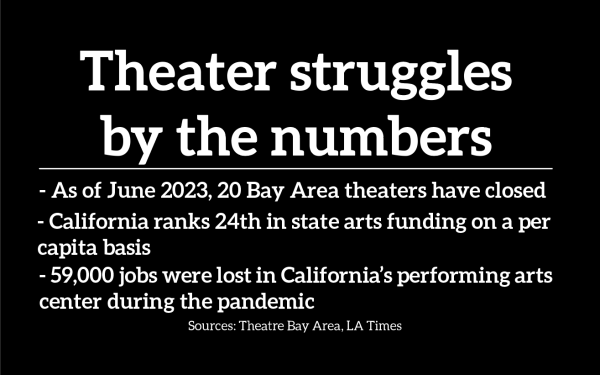$3 million.
This is the deficit that TheatreWorks Silicon Valley, a Tony-award-winning theater company, expects in the next year due to falling ticket subscription rates. The 53-year-old Palo Alto-based nonprofit announced in August that if it doesn’t receive the funds it needs by November, it will not be able to complete its 2023–2024 season.
Artistic Director Giovanna Sardelli has noticed progress in the fundraising campaign.
“We are at 70-something percent of our goal and that’s [been] four weeks … over 400 donations have poured in from across the country,” Sardelli said.
But a significant deficit remains. And unfortunately, TheatreWorks is not alone in its financial difficulties. The arts service organization Theatre Bay Area reported that over 20 Californian theaters have closed or suspended production since 2020.
One of these theaters was the 19-year-old Bay Area Children’s Theatre (BACT), which closed in May due to rising operating costs. Khalia Davis, the former artistic director for BACT, said the closure came as a shock.
“I was upset because I felt like there was more we [BACT] could do,” Davis said. “I think the work that we were giving to the Bay Area community was something of value.”
Along with regional theaters across the country, BACT had to adapt their production style during the pandemic.
“What makes theater special is a shared experience together with other people in one space, watching something and being moved by it,” Davis said. “When you remove the ability to gather together as a community in person, it stops that from happening. … So what we [BACT] had to do during the pandemic was pivot to other ways that we could be bringing the arts to homes, bringing the arts to the community, virtually, digitally and also through our audio series.”
TheatreWorks also produced shows in other mediums.
“We did more online programming than many theaters I know because we wanted to keep our artists involved,” Sardelli said.
A lack of in-person shows made it difficult for theaters to maintain an audience. But loyal patrons continued to attend productions, such as local resident Wynne Dobyns, who has gone to TheatreWorks for over 30 years.
“The plays are interesting,” Dobyns said. “The actors are top-notch. It’s local so we can easily get to it. And it’s more affordable than [going to] San Francisco.”
When TheatreWorks closed its doors during the pandemic, Dobyns attended shows on Zoom.
“I was really impressed with the way that they could coordinate the acting on various Zoom screens from the actors who were in their homes,” she said. “What I really liked about it is that it brought the arts to us when we couldn’t go out to them.”
According to Sardelli, adjusting to the pandemic was difficult for TheatreWorks despite the new skills the organization learned.
“We [theater staff] are used to working together and so the isolation was … emotionally challenging,” she said.
Uncertainty has remained, Sardelli said, even as TheatreWorks returned in person in spring 2021.
“We had a pretty robust subscription base [purchasers of tickets for seasons in advance] and then coming back from the pandemic … half of our subscribers didn’t come back,” she said. “We kept thinking that number would increase steadily and it did, but not anywhere near what it was prior.”

Meghan Crosby-Jolliffe, the membership and community engagement officer for Theatre Bay Area, said that a loss of subscribers following the pandemic has been common across Bay Area theaters.
“They [audiences] are not coming back in the same amounts as quickly as people expected them to,” Crosby-Jolliffe said.
Additionally, Crosby-Jolliffe has noticed a decline in donations to nonprofit theaters.
“There’s a little bit of donor fatigue because people really gave a lot and from their heart during the pandemic to make things continue,” Crosby-Jolliffe said.
Labor has also been difficult to find. According to the LA Times, California’s performing arts sector lost a decade’s worth of jobs in 2021.
“People … left the industry or left the Bay Area because it’s so expensive to be here and it’s just unsustainable if you don’t have income,” Sardelli said. “We’re rebuilding the pool of talent we had, both behind the scenes and onstage.”
To attract a wider audience, TheatreWorks seeks to widen its demographic profile.
“We’re looking at our commitment to everything in terms of diversity, in terms of age range, so that our shows appeal multi-generationally and multi-culturally,” Sardelli said. “So that if you look at the season at TheatreWorks, you go, ‘Oh, there’s lots of shows that seem interesting.’”
For BACT, burnout from the pandemic took a toll, along with struggles to pay all theater staff.
“We did everything we possibly could to revitalize and come back after the shutdown,” Davis said. “It was always like rolling a rock up the hill.”
The Bay Area theater community hoped for a reprieve in late 2022, when the state legislature passed Senate Bill 1116 to establish a payroll fund for nonprofit arts organizations. But the bill has yet to be funded, which means that monetary help from the fund has not reached theaters.
“SB 1116 is supposed to create a support system for small nonprofit companies to more equitably pay the people that work for them,” Crosby-Jolliffe said. “So it’s a really big economic impact once it’s funded.”
With so many theaters taking a financial hit, the future of regional theater in the Bay Area is far from certain. What is certain for Crosby-Jolliffe is that the issue must be tackled.
“The Bay Area theater community is really vibrant and there is so much innovative theater that happens here,” Crosby-Jolliffe said. “If we don’t make sure that … theater is able to thrive here, I think we’d see the ripple effects across the country because so many big shows have gotten their start in development in the Bay Area.”
Davis recognizes that the problem may be too large for theaters to handle on their own.
“If we’re all struggling, then why aren’t we working together?” she said. “I’m hopeful that the future of theater here in the Bay is that we’re doing more collaboration, more partnerships, more theaters coming together and saying, ‘Let’s share our resources.’ … togetherness is going to be the thing that will save us.”





